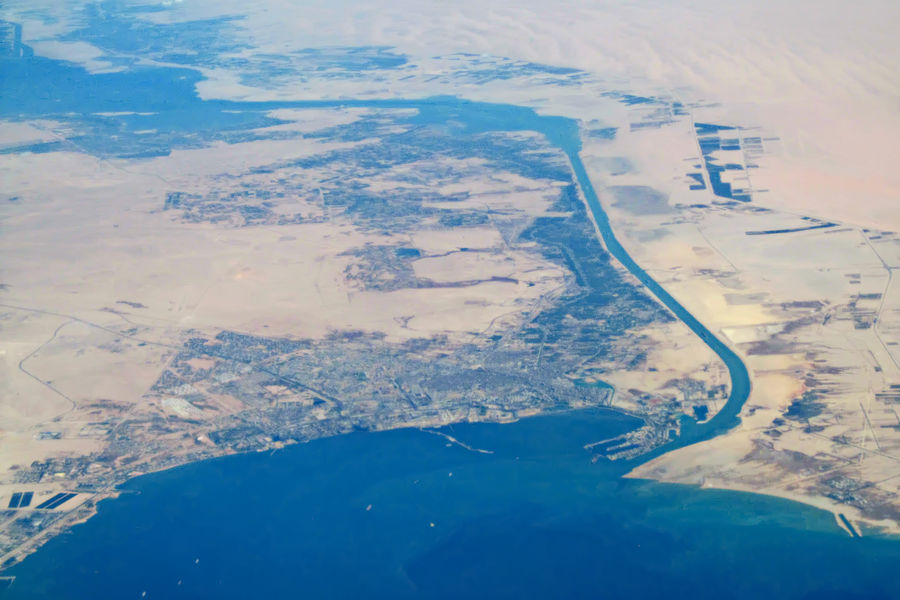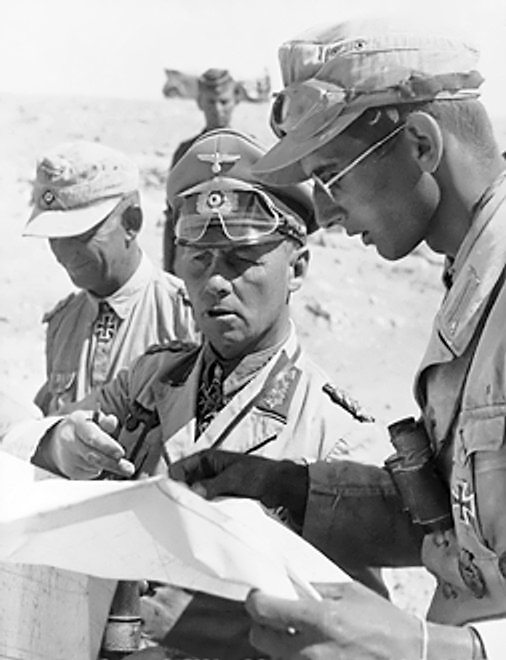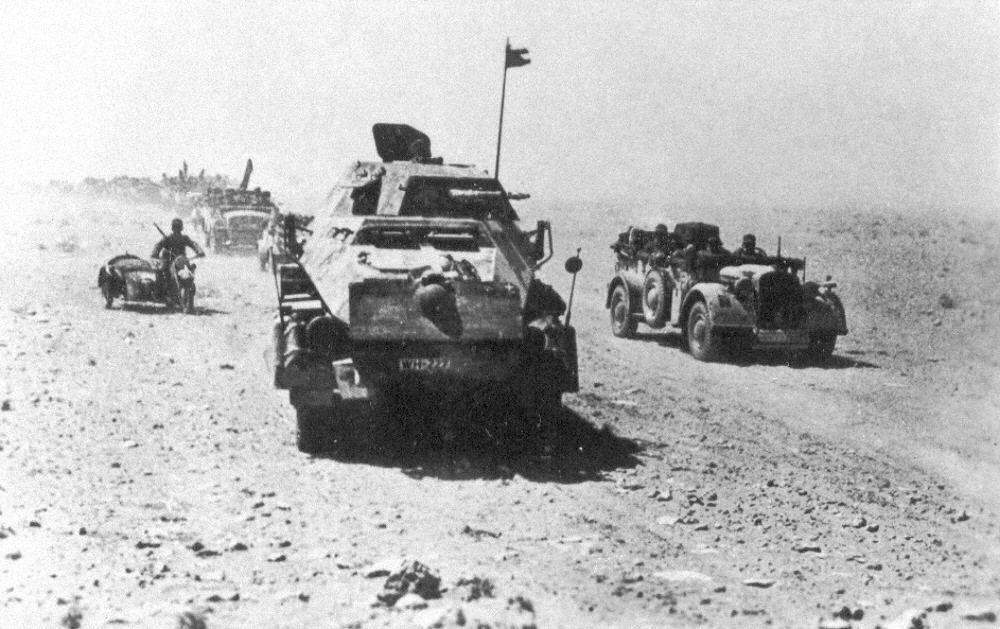|
Battle Of Alam Halfa
The Battle of Alam el Halfa took place between 30 August and 5 September 1942 south of El Alamein during the Western Desert Campaign of the Second World War. '' Panzerarmee Afrika'' (''Generalfeldmarschall'' Erwin Rommel), attempted an envelopment of the British Eighth Army (Lieutenant-General Bernard Montgomery). In (Operation Surf), the last big Axis offensive of the Western Desert Campaign, Rommel intended to defeat the Eighth Army before Allied reinforcements arrived. Montgomery knew of Axis intentions through Ultra signals intercepts and left a gap in the southern sector of the front, knowing that Rommel planned to attack there and deployed the bulk of his armour and artillery around Alam el Halfa Ridge, behind the front. Unlike in previous engagements, Montgomery ordered that the tanks were to be used as anti-tank guns, remaining in their defensive positions on the ridge. When Axis attacks on the ridge failed and short on supplies, Rommel ordered a withdrawal. The 2n ... [...More Info...] [...Related Items...] OR: [Wikipedia] [Google] [Baidu] |
Western Desert Campaign
The Western Desert campaign (Desert War) took place in the Sahara Desert, deserts of Egypt and Libya and was the main Theater (warfare), theatre in the North African campaign of the Second World War. Military operations began in June 1940 with the Italian declaration of war and the Italian invasion of Egypt from Libya in September. Operation Compass, a five-day raid by the British in December 1940, was so successful that it led to the destruction of the Italian Tenth Army (Italy), 10th Army (10ª ) over the following two months. Benito Mussolini sought help from Adolf Hitler, who sent a small Nazi Germany, German force to Tripoli, Libya, Tripoli under List of Adolf Hitler's directives, Directive 22 (11 January). The ( Erwin Rommel) was formally under Italian command, as Italy was the main Axis powers, Axis power in the Mediterranean and North Africa. In the spring of 1941, Rommel led Operation Sonnenblume, which pushed the Allies back to Egypt except for the siege of Tobruk at ... [...More Info...] [...Related Items...] OR: [Wikipedia] [Google] [Baidu] |
Allies Of World War II
The Allies, formally referred to as the United Nations from 1942, were an international Coalition#Military, military coalition formed during World War II (1939–1945) to oppose the Axis powers. Its principal members were the "Four Policemen, Big Four" – the United Kingdom, United States, Soviet Union, and Republic of China (1912–1949), China. Membership in the Allies varied during the course of the war. When the conflict broke out on 1 September 1939, the Allied coalition consisted of the United Kingdom, French Third Republic, France, and Second Polish Republic, Poland, as well as their respective Dependent territory, dependencies, such as British Raj, British India. They were joined by the independent dominions of the British Commonwealth: Canada, Australia, Dominion of New Zealand, New Zealand and Union of South Africa, South Africa. Consequently, the initial alliance resembled Allies of World War I, that of the First World War. As Axis forces began German invasion of ... [...More Info...] [...Related Items...] OR: [Wikipedia] [Google] [Baidu] |
Operation Herkules
Operation Herkules (; ) was the German code-name given to an abortive plan for the invasion of Malta during the Second World War. Through air and sea landings, the Italians and Germans hoped to eliminate Malta as a British air and naval base and secure an uninterrupted flow of supplies across the Mediterranean Sea to Axis forces in Libya and Egypt. Extensive preparations were made for the invasion but the success of other Axis operations – including the Battle of Gazala (26 May to 21 June 1942), the Axis capture of Tobruk on 21 June and Battle of Mersa Matruh, Operation Aïda, the pursuit of the Allies into Egypt – led to Herkules being postponed and then cancelled in November 1942. Origins The Axis plan to invade Malta had its origin in Italian military studies conducted during the Second Italo-Abyssinian War in the mid-1930s. By 1938, ''Comando Supremo'', the Italian army general staff, had estimated the amount of sea transport it would require to move military forces ... [...More Info...] [...Related Items...] OR: [Wikipedia] [Google] [Baidu] |
Suez Canal
The Suez Canal (; , ') is an artificial sea-level waterway in Egypt, Indo-Mediterranean, connecting the Mediterranean Sea to the Red Sea through the Isthmus of Suez and dividing Africa and Asia (and by extension, the Sinai Peninsula from the rest of Egypt). The canal is a key trade route between Europe and Asia. In 1858, French diplomat Ferdinand de Lesseps formed the Suez Canal Company, Compagnie de Suez for the express purpose of building the canal. Construction of the canal lasted from 1859 to 1869. The canal officially opened on 17 November 1869. It offers vessels a direct route between the Atlantic Ocean#North Atlantic, North Atlantic and northern Indian Ocean, Indian oceans via the Mediterranean Sea and the Red Sea, avoiding the South Atlantic and southern Indian oceans and reducing the journey distance from the Arabian Sea to London by approximately , to 10 days at or 8 days at . The canal extends from the northern terminus of Port Said to the southern terminus of Port ... [...More Info...] [...Related Items...] OR: [Wikipedia] [Google] [Baidu] |
Battle Of Gazala
The Battle of Gazala, also the Gazala Offensive (Italian language, Italian: ''Battaglia di Ain el-Gazala'') was fought near the village of Gazala during the Western Desert Campaign of the Second World War, west of the port of Tobruk in Libya, from 26 May to 21 June 1942. Axis powers, Axis troops consisting of Nazi Germany, German (; Erwin Rommel) and Kingdom of Italy, Italian units fought the British Eighth Army (United Kingdom), Eighth Army (General (United Kingdom), General Sir Claude Auchinleck, also Commander-in-chief, Commander-in-Chief Middle East Command, Middle East) composed mainly of British Commonwealth, Indian and Free French troops. The Axis troops made a decoy attack in the north as the main attack moved round the southern flank of the Gazala position. Unexpected resistance at the south end of the line around the Bir Hakeim box by the Free French garrison left with a long and vulnerable supply route around the Gazala Line. Rommel retired to a defensive position b ... [...More Info...] [...Related Items...] OR: [Wikipedia] [Google] [Baidu] |
Tobruk
Tobruk ( ; ; ) is a port city on Libya's eastern Mediterranean coast, near the border with Egypt. It is the capital of the Butnan District (formerly Tobruk District) and has a population of 120,000 (2011 est.)."Tobruk" (history), ''Encyclopædia Britannica'', 2006, Britannica Concise Encyclopedia, ''Concise.Britannica.com'BC-Tobruk. Tobruk was the site of an ancient Greek colony and, later, of a Roman fortress guarding the frontier of Cyrenaica. Over the centuries, Tobruk also served as a waystation along the coastal caravan route. By 1911, Tobruk had become an Italian military post. During World War II, Allied forces, mainly the Australian 6th Division, took Tobruk on 22 January 1941. The Australian 9th Division (" The Rats of Tobruk") pulled back to Tobruk to avoid encirclement after actions at Er Regima and Mechili and reached Tobruk on 9 April 1941. There prolonged fighting followed, against a siege by German and Italian forces. Although the siege was lifted ... [...More Info...] [...Related Items...] OR: [Wikipedia] [Google] [Baidu] |
Port Of Benghazi
The Port of Benghazi is a major seaport in the city of Benghazi, Libya, on the Mediterranean Sea coast within the Gulf of Sidra. History A natural seaport, it was founded as Euesperides by the ancient Greeks of Cyrenaica in the 6th century BC. After passing it to the Egyptian pharaoh Ptolemy III, it was renamed Berenice to honor his wife. The city's current name honors benefactor Ghazi. From the third century onwards, it surpassed Barce and Cyrene as the region's main center. Under the kings of Libya, it was a joint capital with Tripoli, resulting today in state level institutions being located in the second city. This resulted in a rivalry, which being located in different tribal districts, was only intensified. Following a period of slow decline, it was redeveloped after occupation by the Italians in 1912, until the start of the World War II Western Desert campaign from 1942. This resulted in it becoming a hub in the eastern part of the Italian Libya Railways, connecting ... [...More Info...] [...Related Items...] OR: [Wikipedia] [Google] [Baidu] |
Claude Auchinleck
Field marshal (United Kingdom), Field Marshal Sir Claude John Eyre Auchinleck ( ) (21 June 1884 – 23 March 1981), was a British Indian Army commander who saw active service during the world wars. A career soldier who spent much of his military career in British Raj, India, he rose to become commander-in-chief of the British Indian Army, Indian Army by early 1941 during the Second World War. In July 1941 he was appointed commander-in-chief of the Middle East Theatre, but after initial successes the war in North Africa turned against the British-led forces under his command and he was relieved of the post in August 1942 during the North African campaign. In June 1943, he was once again appointed Commander-in-Chief, India, where his support through the organisation of supply, maintenance and training for General William Slim, 1st Viscount Slim, William Slim's Fourteenth Army (United Kingdom), Fourteenth Army played an important role in its success. He served as commander-in-chief ... [...More Info...] [...Related Items...] OR: [Wikipedia] [Google] [Baidu] |
General (United Kingdom)
General (or full general to distinguish it from the lower general officer ranks) is the highest rank achievable by serving officers of the British Army and the Royal Marines. The rank can also be held by Royal Marines officers in tri-service posts, for example, Generals Sir Gordon Messenger and Gwyn Jenkins, Sir Gwyn Jenkins, former Vice-Chief of the Defence Staff (United Kingdom), Vice-Chiefs of the Defence Staff. It ranks above Lieutenant-general (United Kingdom), lieutenant-general and, in the Army, is subordinate to the rank of Field marshal (United Kingdom), field marshal, which is now only awarded as an honorary rank. The rank of general has a NATO-code of Ranks and insignia of NATO, OF-9, and is a four-star rank. It is equivalent to a Admiral (Royal Navy), full admiral in the Royal Navy or an air chief marshal in the Royal Air Force. Officers holding the ranks of Lieutenant-general (United Kingdom), lieutenant-general and Major-general (United Kingdom), major-general m ... [...More Info...] [...Related Items...] OR: [Wikipedia] [Google] [Baidu] |
Counterattack
A counterattack is a tactic employed in response to an attack, with the term originating in "Military exercise, war games". The general objective is to negate or thwart the advantage gained by the enemy during attack, while the specific objectives typically seek to regain lost ground or destroy the attacking enemy (this may take the form of an opposing sports team or Military organization#Commands.2C formations.2C and units, military units). A counter-offensive is a broad-scale counterattack. The counter-offensive is executed after exhausting the enemy's front line, frontline troops and after the enemy Military reserve, reserves had been committed to combat and proven incapable of breaching defenses, but ''before'' the enemy has had the opportunity to assume new defensive positions. Sometimes the counter-offensive can be of a more limited operational maneuver nature, with more limited objectives rather than those seeking attainment of a Strategic goal (military), strategic goal. ... [...More Info...] [...Related Items...] OR: [Wikipedia] [Google] [Baidu] |
First Battle Of El Alamein
The First Battle of El Alamein (1–27 July 1942) was a battle of the Western Desert campaign of World War II, fought in Egypt between Axis (German and Italian) forces of the Panzer Army Africa—which included the under Field Marshal Erwin Rommel—and Allied (British Empire and Commonwealth) forces of the Eighth Army under General Claude Auchinleck. In this battle the British halted a second advance by the Axis forces into Egypt. Axis positions near El Alamein, only from Alexandria, were dangerously close to the ports and cities of Egypt, the base facilities of the Commonwealth forces and the Suez Canal. However, the Axis forces were too far from their base at Tripoli in Libya to remain at El Alamein indefinitely, which led both sides to accumulate supplies for more offensives, against the constraints of time and distance. Background Retreat from Gazala After their defeat at the Battle of Gazala in Eastern Libya in June 1942, the British Eighth Army, commanded by ... [...More Info...] [...Related Items...] OR: [Wikipedia] [Google] [Baidu] |
Second Battle Of El Alamein
The Second Battle of El Alamein (23 October – 11 November 1942) was a battle of the Second World War that took place near the Egyptian Railway station, railway halt of El Alamein. The First Battle of El Alamein and the Battle of Alam el Halfa had prevented the Axis powers, Axis from advancing further into Egypt. In October 1942 Lieutenant-general (United Kingdom), Lieutenant-General Bernard Montgomery, commander of Eighth Army (United Kingdom), Eighth Army, opened his offensive against the Axis forces. In a 13-day battle the Axis ''Panzerarmee Afrika'' was crushed and forced to retreat from Egypt and Libya to the borders of Tunisia. The Allied victory at El Alamein was the beginning of the end of the Western Desert Campaign. The battle ended the Axis threat to the Middle East and Iran and revived the morale of the western Allies, being their first big success against the Axis since Operation Crusader in late 1941. The end of the battle coincided with the Allied invasion of F ... [...More Info...] [...Related Items...] OR: [Wikipedia] [Google] [Baidu] |










